[English] 日本語
 Yorodumi
Yorodumi- EMDB-35106: Structure of beta-arrestin1 in complex with a phosphopeptide corr... -
+ Open data
Open data
- Basic information
Basic information
| Entry |  | |||||||||
|---|---|---|---|---|---|---|---|---|---|---|
| Title | Structure of beta-arrestin1 in complex with a phosphopeptide corresponding to the human C-X-C chemokine receptor type 4, CXCR4 (Local refine) | |||||||||
 Map data Map data | ||||||||||
 Sample Sample |
| |||||||||
| Function / homology |  Function and homology information Function and homology information V2 vasopressin receptor binding / V2 vasopressin receptor binding /  alpha-1A adrenergic receptor binding / alpha-1A adrenergic receptor binding /  follicle-stimulating hormone receptor binding / Activation of SMO / sensory perception of touch / C-X-C motif chemokine 12 receptor activity / regulation of viral process / G alpha (s) signalling events / follicle-stimulating hormone receptor binding / Activation of SMO / sensory perception of touch / C-X-C motif chemokine 12 receptor activity / regulation of viral process / G alpha (s) signalling events /  alpha-1B adrenergic receptor binding / positive regulation of vascular wound healing ... alpha-1B adrenergic receptor binding / positive regulation of vascular wound healing ... V2 vasopressin receptor binding / V2 vasopressin receptor binding /  alpha-1A adrenergic receptor binding / alpha-1A adrenergic receptor binding /  follicle-stimulating hormone receptor binding / Activation of SMO / sensory perception of touch / C-X-C motif chemokine 12 receptor activity / regulation of viral process / G alpha (s) signalling events / follicle-stimulating hormone receptor binding / Activation of SMO / sensory perception of touch / C-X-C motif chemokine 12 receptor activity / regulation of viral process / G alpha (s) signalling events /  alpha-1B adrenergic receptor binding / positive regulation of vascular wound healing / positive regulation of macrophage migration inhibitory factor signaling pathway / follicle-stimulating hormone signaling pathway / protein phosphorylated amino acid binding / positive regulation of mesenchymal stem cell migration / alpha-1B adrenergic receptor binding / positive regulation of vascular wound healing / positive regulation of macrophage migration inhibitory factor signaling pathway / follicle-stimulating hormone signaling pathway / protein phosphorylated amino acid binding / positive regulation of mesenchymal stem cell migration /  angiotensin receptor binding / neuron recognition / response to ultrasound / response to tacrolimus / telencephalon cell migration / C-X-C chemokine receptor activity / Specification of primordial germ cells / CXCL12-activated CXCR4 signaling pathway / Lysosome Vesicle Biogenesis / AP-2 adaptor complex binding / angiotensin receptor binding / neuron recognition / response to ultrasound / response to tacrolimus / telencephalon cell migration / C-X-C chemokine receptor activity / Specification of primordial germ cells / CXCL12-activated CXCR4 signaling pathway / Lysosome Vesicle Biogenesis / AP-2 adaptor complex binding /  myosin light chain binding / Golgi Associated Vesicle Biogenesis / MAP2K and MAPK activation / Ub-specific processing proteases / myosin light chain binding / Golgi Associated Vesicle Biogenesis / MAP2K and MAPK activation / Ub-specific processing proteases /  myelin maintenance / positive regulation of vasculature development / myelin maintenance / positive regulation of vasculature development /  regulation of programmed cell death / positive regulation of smooth muscle cell apoptotic process / C-C chemokine receptor activity / endothelial tube morphogenesis / endothelial cell differentiation / negative regulation of interleukin-8 production / Cargo recognition for clathrin-mediated endocytosis / C-C chemokine binding / Signaling by ROBO receptors / regulation of programmed cell death / positive regulation of smooth muscle cell apoptotic process / C-C chemokine receptor activity / endothelial tube morphogenesis / endothelial cell differentiation / negative regulation of interleukin-8 production / Cargo recognition for clathrin-mediated endocytosis / C-C chemokine binding / Signaling by ROBO receptors /  Clathrin-mediated endocytosis / clathrin adaptor activity / Clathrin-mediated endocytosis / clathrin adaptor activity /  regulation of chemotaxis / cellular response to organonitrogen compound / positive regulation of chemotaxis / Formation of definitive endoderm / positive regulation of dendrite extension / regulation of G protein-coupled receptor signaling pathway / arrestin family protein binding / G protein-coupled receptor internalization / anchoring junction / Chemokine receptors bind chemokines / Thrombin signalling through proteinase activated receptors (PARs) / dendritic cell chemotaxis / mitogen-activated protein kinase kinase binding / positive regulation of Rho protein signal transduction / regulation of chemotaxis / cellular response to organonitrogen compound / positive regulation of chemotaxis / Formation of definitive endoderm / positive regulation of dendrite extension / regulation of G protein-coupled receptor signaling pathway / arrestin family protein binding / G protein-coupled receptor internalization / anchoring junction / Chemokine receptors bind chemokines / Thrombin signalling through proteinase activated receptors (PARs) / dendritic cell chemotaxis / mitogen-activated protein kinase kinase binding / positive regulation of Rho protein signal transduction /  clathrin binding / positive regulation of oligodendrocyte differentiation / clathrin binding / positive regulation of oligodendrocyte differentiation /  stress fiber assembly / negative regulation of Notch signaling pathway / epithelial cell development / cell leading edge / stress fiber assembly / negative regulation of Notch signaling pathway / epithelial cell development / cell leading edge /  pseudopodium / cellular response to cytokine stimulus / positive regulation of insulin secretion involved in cellular response to glucose stimulus / pseudopodium / cellular response to cytokine stimulus / positive regulation of insulin secretion involved in cellular response to glucose stimulus /  small molecule binding / cysteine-type endopeptidase inhibitor activity involved in apoptotic process / detection of temperature stimulus involved in sensory perception of pain / regulation of calcium ion transport / negative regulation of interleukin-6 production / positive regulation of receptor internalization / small molecule binding / cysteine-type endopeptidase inhibitor activity involved in apoptotic process / detection of temperature stimulus involved in sensory perception of pain / regulation of calcium ion transport / negative regulation of interleukin-6 production / positive regulation of receptor internalization /  phototransduction / Binding and entry of HIV virion / phototransduction / Binding and entry of HIV virion /  coreceptor activity / detection of mechanical stimulus involved in sensory perception of pain / coreceptor activity / detection of mechanical stimulus involved in sensory perception of pain /  regulation of cell adhesion / regulation of cell adhesion /  clathrin-coated pit / cardiac muscle contraction / negative regulation of protein ubiquitination / clathrin-coated pit / cardiac muscle contraction / negative regulation of protein ubiquitination /  insulin-like growth factor receptor binding / insulin-like growth factor receptor binding /  visual perception / visual perception /  neurogenesis / neurogenesis /  GTPase activator activity / cell chemotaxis / negative regulation of protein phosphorylation / response to activity / GTPase activator activity / cell chemotaxis / negative regulation of protein phosphorylation / response to activity /  ubiquitin binding / positive regulation of protein ubiquitination / G protein-coupled receptor binding / G protein-coupled receptor activity / calcium-mediated signaling / nuclear estrogen receptor binding / ubiquitin binding / positive regulation of protein ubiquitination / G protein-coupled receptor binding / G protein-coupled receptor activity / calcium-mediated signaling / nuclear estrogen receptor binding /  phosphoprotein binding / phosphoprotein binding /  brain development / brain development /  neuron migration / response to virus / adenylate cyclase-modulating G protein-coupled receptor signaling pathway / negative regulation of ERK1 and ERK2 cascade / neuron migration / response to virus / adenylate cyclase-modulating G protein-coupled receptor signaling pathway / negative regulation of ERK1 and ERK2 cascade /  endocytosis / cellular response to xenobiotic stimulus / late endosome endocytosis / cellular response to xenobiotic stimulus / late endosomeSimilarity search - Function | |||||||||
| Biological species |   Rattus norvegicus (Norway rat) / Rattus norvegicus (Norway rat) /   Homo sapiens (human) / Homo sapiens (human) /   Mus musculus (house mouse) Mus musculus (house mouse) | |||||||||
| Method |  single particle reconstruction / single particle reconstruction /  cryo EM / Resolution: 4.45 Å cryo EM / Resolution: 4.45 Å | |||||||||
 Authors Authors | Maharana J / Sarma P / Yadav MK / Banerjee R / Shukla AK | |||||||||
| Funding support |  India, 1 items India, 1 items
| |||||||||
 Citation Citation |  Journal: Mol.Cell / Year: 2023 Journal: Mol.Cell / Year: 2023Title: Structure of beta-arrestin in complex with a phosphopeptide Authors: Maharana J / Sarma P / Yadav MK / Banerjee R / Shukla AK | |||||||||
| History |
|
- Structure visualization
Structure visualization
| Supplemental images |
|---|
- Downloads & links
Downloads & links
-EMDB archive
| Map data |  emd_35106.map.gz emd_35106.map.gz | 59.4 MB |  EMDB map data format EMDB map data format | |
|---|---|---|---|---|
| Header (meta data) |  emd-35106-v30.xml emd-35106-v30.xml emd-35106.xml emd-35106.xml | 20.7 KB 20.7 KB | Display Display |  EMDB header EMDB header |
| FSC (resolution estimation) |  emd_35106_fsc.xml emd_35106_fsc.xml | 8.4 KB | Display |  FSC data file FSC data file |
| Images |  emd_35106.png emd_35106.png | 31.9 KB | ||
| Others |  emd_35106_half_map_1.map.gz emd_35106_half_map_1.map.gz emd_35106_half_map_2.map.gz emd_35106_half_map_2.map.gz | 59.2 MB 59.2 MB | ||
| Archive directory |  http://ftp.pdbj.org/pub/emdb/structures/EMD-35106 http://ftp.pdbj.org/pub/emdb/structures/EMD-35106 ftp://ftp.pdbj.org/pub/emdb/structures/EMD-35106 ftp://ftp.pdbj.org/pub/emdb/structures/EMD-35106 | HTTPS FTP |
-Related structure data
| Related structure data | 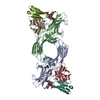 8i0qMC  8go8C  8gocC 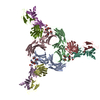 8gooC 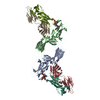 8gp3C  8i0nC 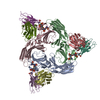 8i0zC 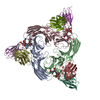 8i10C M: atomic model generated by this map C: citing same article ( |
|---|---|
| Similar structure data | Similarity search - Function & homology  F&H Search F&H Search |
- Links
Links
| EMDB pages |  EMDB (EBI/PDBe) / EMDB (EBI/PDBe) /  EMDataResource EMDataResource |
|---|---|
| Related items in Molecule of the Month |
- Map
Map
| File |  Download / File: emd_35106.map.gz / Format: CCP4 / Size: 64 MB / Type: IMAGE STORED AS FLOATING POINT NUMBER (4 BYTES) Download / File: emd_35106.map.gz / Format: CCP4 / Size: 64 MB / Type: IMAGE STORED AS FLOATING POINT NUMBER (4 BYTES) | ||||||||||||||||||||
|---|---|---|---|---|---|---|---|---|---|---|---|---|---|---|---|---|---|---|---|---|---|
| Voxel size | X=Y=Z: 1.6463 Å | ||||||||||||||||||||
| Density |
| ||||||||||||||||||||
| Symmetry | Space group: 1 | ||||||||||||||||||||
| Details | EMDB XML:
|
-Supplemental data
-Half map: #2
| File | emd_35106_half_map_1.map | ||||||||||||
|---|---|---|---|---|---|---|---|---|---|---|---|---|---|
| Projections & Slices |
| ||||||||||||
| Density Histograms |
-Half map: #1
| File | emd_35106_half_map_2.map | ||||||||||||
|---|---|---|---|---|---|---|---|---|---|---|---|---|---|
| Projections & Slices |
| ||||||||||||
| Density Histograms |
- Sample components
Sample components
-Entire : Peptide5 bound beta-arrestin1 in complex with Fab30 - Local refine
| Entire | Name: Peptide5 bound beta-arrestin1 in complex with Fab30 - Local refine |
|---|---|
| Components |
|
-Supramolecule #1: Peptide5 bound beta-arrestin1 in complex with Fab30 - Local refine
| Supramolecule | Name: Peptide5 bound beta-arrestin1 in complex with Fab30 - Local refine type: complex / ID: 1 / Chimera: Yes / Parent: 0 / Macromolecule list: all |
|---|---|
| Molecular weight | Theoretical: 190 KDa |
-Supramolecule #2: Beta arrestin 1
| Supramolecule | Name: Beta arrestin 1 / type: complex / ID: 2 / Chimera: Yes / Parent: 1 / Macromolecule list: #1 |
|---|---|
| Source (natural) | Organism:   Rattus norvegicus (Norway rat) Rattus norvegicus (Norway rat) |
-Supramolecule #3: CXC chemokine receptor type 4 phosphopeptide
| Supramolecule | Name: CXC chemokine receptor type 4 phosphopeptide / type: complex / ID: 3 / Chimera: Yes / Parent: 1 / Macromolecule list: #4 / Details: Chemically synthesized |
|---|---|
| Source (natural) | Organism:   Homo sapiens (human) Homo sapiens (human) |
-Supramolecule #4: Fab30
| Supramolecule | Name: Fab30 / type: complex / ID: 4 / Chimera: Yes / Parent: 1 / Macromolecule list: #2-#3 |
|---|---|
| Source (natural) | Organism:   Mus musculus (house mouse) Mus musculus (house mouse) |
-Macromolecule #1: Beta-arrestin-1
| Macromolecule | Name: Beta-arrestin-1 / type: protein_or_peptide / ID: 1 / Number of copies: 2 / Enantiomer: LEVO |
|---|---|
| Source (natural) | Organism:   Rattus norvegicus (Norway rat) Rattus norvegicus (Norway rat) |
| Molecular weight | Theoretical: 47.088508 KDa |
| Recombinant expression | Organism:   Escherichia coli (E. coli) Escherichia coli (E. coli) |
| Sequence | String: MGDKGTRVFK KASPNGKLTV YLGKRDFVDH IDLVDPVDGV VLVDPEYLKE RRVYVTLTCA FRYGREDLDV LGLTFRKDLF VANVQSFPP APEDKKPLTR LQERLIKKLG EHAYPFTFEI PPNLPCSVTL QPGPEDTGKA CGVDYEVKAF CAENLEEKIH K RNSVRLVI ...String: MGDKGTRVFK KASPNGKLTV YLGKRDFVDH IDLVDPVDGV VLVDPEYLKE RRVYVTLTCA FRYGREDLDV LGLTFRKDLF VANVQSFPP APEDKKPLTR LQERLIKKLG EHAYPFTFEI PPNLPCSVTL QPGPEDTGKA CGVDYEVKAF CAENLEEKIH K RNSVRLVI RKVQYAPERP GPQPTAETTR QFLMSDKPLH LEASLDKEIY YHGEPISVNV HVTNNTNKTV KKIKISVRQY AD ICLFNTA QYKCPVAMEE ADDTVAPSST FCKVYTLTPF LANNREKRGL ALDGKLKHED TNLASSTLLR EGANREILGI IVS YKVKVK LVVSRGGLLG DLASSDVAVE LPFTLMHPKP KEEPPHREVP ESETPVDTNL IELDTNDDDI VFEDFARQRL KGMK DDKDE EDDGTGSPHL NNR |
-Macromolecule #2: Fab30 Heavy Chain
| Macromolecule | Name: Fab30 Heavy Chain / type: protein_or_peptide / ID: 2 / Number of copies: 2 / Enantiomer: LEVO |
|---|---|
| Source (natural) | Organism:   Mus musculus (house mouse) Mus musculus (house mouse) |
| Molecular weight | Theoretical: 25.512354 KDa |
| Recombinant expression | Organism:   Escherichia coli (E. coli) Escherichia coli (E. coli) |
| Sequence | String: EISEVQLVES GGGLVQPGGS LRLSCAASGF NVYSSSIHWV RQAPGKGLEW VASISSYYGY TYYADSVKGR FTISADTSKN TAYLQMNSL RAEDTAVYYC ARSRQFWYSG LDYWGQGTLV TVSSASTKGP SVFPLAPSSK STSGGTAALG CLVKDYFPEP V TVSWNSGA ...String: EISEVQLVES GGGLVQPGGS LRLSCAASGF NVYSSSIHWV RQAPGKGLEW VASISSYYGY TYYADSVKGR FTISADTSKN TAYLQMNSL RAEDTAVYYC ARSRQFWYSG LDYWGQGTLV TVSSASTKGP SVFPLAPSSK STSGGTAALG CLVKDYFPEP V TVSWNSGA LTSGVHTFPA VLQSSGLYSL SSVVTVPSSS LGTQTYICNV NHKPSNTKVD KKVEPKSCDK THHHHHHHH |
-Macromolecule #3: Fab30 Light Chain
| Macromolecule | Name: Fab30 Light Chain / type: protein_or_peptide / ID: 3 / Number of copies: 2 / Enantiomer: LEVO |
|---|---|
| Source (natural) | Organism:   Mus musculus (house mouse) Mus musculus (house mouse) |
| Molecular weight | Theoretical: 23.435064 KDa |
| Recombinant expression | Organism:   Escherichia coli (E. coli) Escherichia coli (E. coli) |
| Sequence | String: SDIQMTQSPS SLSASVGDRV TITCRASQSV SSAVAWYQQK PGKAPKLLIY SASSLYSGVP SRFSGSRSGT DFTLTISSLQ PEDFATYYC QQYKYVPVTF GQGTKVEIKR TVAAPSVFIF PPSDSQLKSG TASVVCLLNN FYPREAKVQW KVDNALQSGN S QESVTEQD ...String: SDIQMTQSPS SLSASVGDRV TITCRASQSV SSAVAWYQQK PGKAPKLLIY SASSLYSGVP SRFSGSRSGT DFTLTISSLQ PEDFATYYC QQYKYVPVTF GQGTKVEIKR TVAAPSVFIF PPSDSQLKSG TASVVCLLNN FYPREAKVQW KVDNALQSGN S QESVTEQD SKDSTYSLSS TLTLSKADYE KHKVYACEVT HQGLSSPVTK SFNRGEC |
-Macromolecule #4: C-X-C chemokine receptor type 4
| Macromolecule | Name: C-X-C chemokine receptor type 4 / type: protein_or_peptide / ID: 4 / Number of copies: 2 / Enantiomer: LEVO |
|---|---|
| Source (natural) | Organism:   Homo sapiens (human) Homo sapiens (human) |
| Molecular weight | Theoretical: 2.38053 KDa |
| Sequence | String: GHSSV(SEP)(TPO)E(SEP)E (SEP)(SEP)(SEP)FH(SEP)(SEP) |
-Experimental details
-Structure determination
| Method |  cryo EM cryo EM |
|---|---|
 Processing Processing |  single particle reconstruction single particle reconstruction |
| Aggregation state | particle |
- Sample preparation
Sample preparation
| Buffer | pH: 7.4 Component:
| |||||||||
|---|---|---|---|---|---|---|---|---|---|---|
| Vitrification | Cryogen name: ETHANE / Chamber humidity: 90 % / Chamber temperature: 283.15 K / Instrument: LEICA EM GP / Details: Blotted for 3 seconds before plunging.. |
- Electron microscopy
Electron microscopy
| Microscope | TFS GLACIOS |
|---|---|
| Electron beam | Acceleration voltage: 200 kV / Electron source:  FIELD EMISSION GUN FIELD EMISSION GUN |
| Electron optics | Illumination mode: FLOOD BEAM / Imaging mode: BRIGHT FIELD Bright-field microscopy / Cs: 2.7 mm / Nominal defocus max: 2.5 µm / Nominal defocus min: 0.5 µm / Nominal magnification: 46000 Bright-field microscopy / Cs: 2.7 mm / Nominal defocus max: 2.5 µm / Nominal defocus min: 0.5 µm / Nominal magnification: 46000 |
| Sample stage | Cooling holder cryogen: NITROGEN |
| Image recording | Film or detector model: GATAN K3 (6k x 4k) / Detector mode: COUNTING / Number real images: 5637 / Average electron dose: 49.3 e/Å2 |
 Movie
Movie Controller
Controller



























 Z
Z Y
Y X
X


















